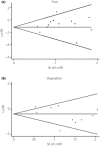Higher intake of fruits, vegetables or their fiber reduces the risk of type 2 diabetes: A meta-analysis
- PMID: 26816602
- PMCID: PMC4718092
- DOI: 10.1111/jdi.12376
Higher intake of fruits, vegetables or their fiber reduces the risk of type 2 diabetes: A meta-analysis
Abstract
Aims/introduction: Some previous studies reported no significant association of consuming fruit or vegetables, or fruit and vegetables combined, with type 2 diabetes. Others reported that only a greater intake of green leafy vegetables reduced the risk of type 2 diabetes. To further investigate the relationship between them, we carried out a meta-analysis to estimate the independent effects of the intake of fruit, vegetables and fiber on the risk of type 2 diabetes.
Materials and methods: Searches of MEDLINE and EMBASE for reports of prospective cohort studies published from 1 January 1966 to 21 July 2014 were carried out, checking reference lists, hand-searching journals and contacting experts.
Results: The primary analysis included a total of 23 (11 + 12) articles. The pooled maximum-adjusted relative risk of type 2 diabetes for the highest intake vs the lowest intake were 0.91 (95% confidence interval [CI] 0.87-0.96) for total fruits, 0.75 (95% CI 0.66-0.84) for blueberries, 0.87 (95% CI 0.81-0.93) for green leafy vegetables, 0.72 (95% CI 0.57-0.90) for yellow vegetables, 0.82 (95% CI 0.67-0.99) for cruciferous vegetables and 0.93 (95% CI 0.88-0.99) for fruit fiber in these high-quality studies in which scores were seven or greater, and 0.87 (95% CI 0.80-0.94) for vegetable fiber in studies with a follow-up period of 10 years or more.
Conclusions: A higher intake of fruit, especially berries, and green leafy vegetables, yellow vegetables, cruciferous vegetables or their fiber is associated with a lower risk of type 2 diabetes.
Keywords: Meta‐analysis; Nutrition intake; Type 2 diabetes.
Figures






Similar articles
-
Fruit and vegetable intake and risk of type 2 diabetes mellitus: meta-analysis of prospective cohort studies.BMJ Open. 2014 Nov 5;4(11):e005497. doi: 10.1136/bmjopen-2014-005497. BMJ Open. 2014. PMID: 25377009 Free PMC article.
-
Fruit and vegetable intake and incidence of type 2 diabetes mellitus: systematic review and meta-analysis.BMJ. 2010 Aug 18;341:c4229. doi: 10.1136/bmj.c4229. BMJ. 2010. PMID: 20724400 Free PMC article. Review.
-
Fruit and vegetable intake and risk of incident of type 2 diabetes: results from the consortium on health and ageing network of cohorts in Europe and the United States (CHANCES).Eur J Clin Nutr. 2017 Jan;71(1):83-91. doi: 10.1038/ejcn.2016.143. Epub 2016 Aug 17. Eur J Clin Nutr. 2017. PMID: 27530474 Free PMC article.
-
Consumption of citrus and cruciferous vegetables with incident type 2 diabetes mellitus based on a meta-analysis of prospective study.Prim Care Diabetes. 2016 Aug;10(4):272-80. doi: 10.1016/j.pcd.2015.12.004. Epub 2016 Jan 6. Prim Care Diabetes. 2016. PMID: 26778708 Review.
-
Vegetable and fruit intake and risk of type 2 diabetes: Japan Public Health Center-based Prospective Study.Br J Nutr. 2013 Feb 28;109(4):709-17. doi: 10.1017/S0007114512001705. Epub 2012 May 9. Br J Nutr. 2013. PMID: 22571826
Cited by
-
The Relationship between Food Security Status and Fruit and Vegetable Intake during the COVID-19 Pandemic.Nutrients. 2021 Feb 24;13(3):712. doi: 10.3390/nu13030712. Nutrients. 2021. PMID: 33668207 Free PMC article.
-
Skin Carotenoid Levels Are Associated with Demographic Factors, Body Size, and Fruit and Vegetable Intake in the Japanese Population.Nutrients. 2024 Jul 4;16(13):2133. doi: 10.3390/nu16132133. Nutrients. 2024. PMID: 38999880 Free PMC article.
-
Fruits and vegetables intake improves birth outcomes of women with gestational diabetes mellitus and hypertensive disorders of pregnancy.BMC Nutr. 2024 Jan 2;10(1):2. doi: 10.1186/s40795-023-00814-w. BMC Nutr. 2024. PMID: 38167235 Free PMC article.
-
Carotenoids: Dietary Sources, Extraction, Encapsulation, Bioavailability, and Health Benefits-A Review of Recent Advancements.Antioxidants (Basel). 2022 Apr 18;11(4):795. doi: 10.3390/antiox11040795. Antioxidants (Basel). 2022. PMID: 35453480 Free PMC article. Review.
-
Three-year trends in dietary behaviours among mothers, teenagers and children from SNAP-Ed (Supplemental Nutrition Assistance Program-Education) eligible households across California.Public Health Nutr. 2020 Jan;23(1):3-12. doi: 10.1017/S1368980019003197. Epub 2019 Nov 20. Public Health Nutr. 2020. PMID: 31744585 Free PMC article.
References
-
- Guariguata L, Whiting DR, Hambleton I, et al Global estimates of diabetes prevalence for 2013 and projections for 2035. Diabetes Res Clin Pract 2014; 103: 137–149. - PubMed
-
- Whiting DR, Guariguata L, Weil C, et al IDF diabetes atlas: global estimates of the prevalence of diabetes for 2011 and 2030. Diabetes Res Clin Pract 2011; 94: 311–321. - PubMed
-
- Shaw JE, Sicree RA, Zimmet PZ. Global estimates of the prevalence of diabetes for 2010 and 2030. Diabetes Res Clin Pract 2010; 87: 4–14. - PubMed
-
- Steyn NP, Mann J, Bennett PH, et al Diet, nutrition and the prevention of type 2 diabetes. Public Health Nutr 2004; 7: 147–165. - PubMed
Publication types
MeSH terms
LinkOut - more resources
Full Text Sources
Other Literature Sources
Medical

